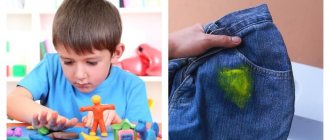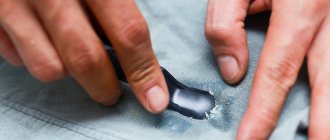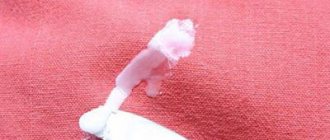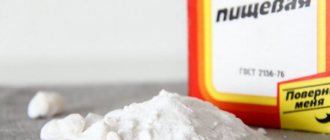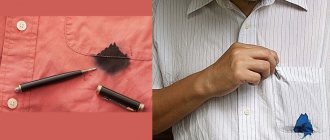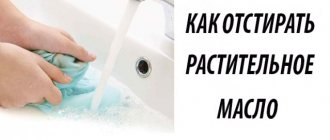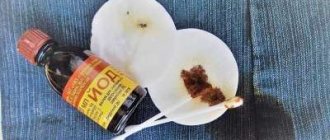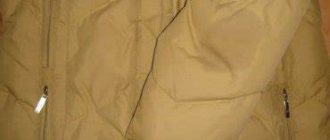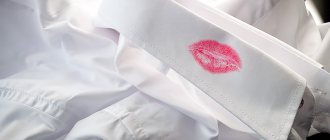Removing a marker depending on its composition
The type of marker is determined by the inscription on the package or by the appearance of the stain. Water-soluble leaves a translucent trace of bright color. Metal markers create a thick line on fabric that cannot be washed off with water. A stroke from a chalk felt-tip pen with vague outlines. An oil or permanent mark has a glossy sheen.
There are several methods using home remedies to remove marker from clothes based on its base. The chosen method should be pre-tested on an inconspicuous area so as not to damage the clothing. You need to work on the stain from the wrong side, and put a paper towel on the front side, which will absorb the dye.
Determining the type and color of fabric
In order to not only remove the permanent marker, but also preserve the texture of the fibers, you need to figure out how to remove marks from different types of clothing.
You can determine the type of fabric thanks to the label on which the composition is indicated. Based on the information received, clean the marker using the appropriate method. If it is impossible to determine the composition of the material, begin removal using gentle methods, such as toothpaste, Fairy.
When cleaning fabric, remember:
- Solvents are used if less aggressive methods do not help.
- Dry powders cause fabric to fade. Not recommended for use.
- Rub the damaged area from the borders to the center so as not to enlarge it.
- Use chemical compounds with caution.
- If the suggested methods do not help resolve the problem, contact a dry cleaner.
Chalk and water based removal
Dealing with chalk or water-based marker or felt-tip pen stains is not difficult at all. It is enough to treat the stain with dish gel, lightly rub and wait until it dries. Then wash the contaminated area with laundry soap and wash. The method is suitable for colored and patterned fabrics.
Water pigment is removed from leather products with a concentrated soap solution of laundry soap. You need to dip a soft brush into the resulting liquid and treat the dirt. Blot the residue with a dry cloth.
You can remove water-based dye from a white shirt by soaking it in oxygen bleach and then washing it in a machine.
Ammonia has been successfully used for white clothes and T-shirts. It has a bleaching effect for colored fabrics; it is diluted with water in the ratio of a tablespoon to 2 glasses of water. Adding powder or soap shavings will enhance the effect.
People's Councils
Some markers contain substances that cannot be removed using improvised means. In such cases, it is recommended to use:
- gasoline. It will help get rid of any traces. The liquid is applied to trousers or other items of clothing and left for several minutes. The disadvantage of this option is the unpleasant smell. But you can get rid of it with washing and airing. It is not advisable to clean children's things in this way;
- salt. A glass of table salt added to the powder compartment during washing will help deal with stains;
- mustard. It is used if you need to clean a woolen blanket or other product made from this material. The seasoning is diluted with water until a creamy consistency is obtained and applied to the contaminated area, leaving until completely dry. After this, you need to carefully scrape off the mustard, which will come off along with the stain;
- turpentine. This substance is excellent for cleaning silk. A cotton swab is soaked in it and applied to the ink marks. At the same time, they should turn pale. The item is washed with laundry soap;
- a special composition that includes borax, citric acid, vinegar and milk. This mixture is suitable for cleaning satin. The ingredients are combined in equal quantities, applied to the stain for half an hour, and then washed;
- citrus juice. Orange, tangerine and lemon juice are sometimes used to clean velvet products. Apply the juice to the marker marks and leave for 60 minutes. After this, the products are rinsed with cold water;
- acetone. It is necessary if jeans are drawn. The product is applied to the fabric and blotted with a napkin. After this, the item must be washed in the washing machine.
- Removing stains with lemon juice
There are many methods for cleaning fabrics from marker and felt-tip pen. But it is important to choose it correctly so as not to spoil the product and achieve success in removing the stain.
If the marker is alcohol
Alcohol marker stains are not easy to remove. It is recommended to start fighting them with vodka. To do this, moisten a cotton pad and apply to the stain. Place a napkin on the opposite side. Do not rub to prevent the stain from spreading further. Vodka will dissolve the pigment, and the napkin will help protect the clean part of the clothing from contamination. If the fabric is clean, all that remains is to do the washing. Vodka can be replaced with cologne or alcohol.
The alcohol composition is also suitable for leather material, which after cleansing is wiped with cream.
If the result is negative, wash the felt-tip pen from Vanish clothes. The product should be thoroughly moistened with a damp cloth under and near the print. You must act carefully so that the dye does not get on the adjacent area. Wait a few minutes and rub. Machine wash with Vanish added. In most cases, this method helps.
An unusual, but nevertheless effective method is the use of hairspray. Spray it onto the marker stain, placing a napkin on the inside, and begin to rub until the varnish is dry. Then rinse the product with running water and wash by hand. Do not allow the varnish to dry, otherwise it will only set the stain.
You can try to remove stains from a colored marker with a mixture of ammonia and soda (2:1). Apply the mixture to the stain and rub into the fabric with gentle movements using an old toothbrush. Rinse off the soda with warm water and complete the procedure with the usual washing.
A paste of lemon juice and cream of tartar will help remove marker stains from clothing. It is left to act for 1 hour, and then the item is washed in a machine.
Alcohol markers can be easily removed from leather products with tea tree oil. It is applied to a cotton pad and applied to the stain. After interaction, the paint will dissolve even without additional friction. Blot traces of oil with a napkin.
Old alcohol stains
Stubborn stains from alcohol markers can be removed with table vinegar. Apply the liquid to problem areas until the material gets wet and leave until dry. Sprinkle baking soda onto a cloth slightly damp with vinegar and rub gently. Apply baking soda to heavily soiled areas on both sides. The exposure should not be prolonged so that the fabric does not lose its color. Rinse off any remaining composition with running water and wash the product.
For dense fabrics, use 9% vinegar, and for delicate ones it is diluted with water at the rate of 3 tbsp. l. per glass of water.
Old contours from a felt-tip pen or marker are washed with a composition of laundry soap shavings with the addition of alcohol.
Dried stains can also be treated with glycerin and left for a couple of hours. After this, wash in warm, soapy water with added salt.
Differences between felt-tip pen and marker
Both stationery items were invented around the same time - in the 1960s.
Despite this, the marker initially became more popular, especially among office workers, as it showed its stability on various surfaces. A felt-tip pen is associated with creativity; children and adults love to draw with it. It is used much less frequently in work situations. There are practically no differences in the manufacturing principle, but their areas of application are different due to their resistance to abrasion and external factors (weather, moisture, temperature). The felt-tip pen is used only for working on paper, since it quickly wears off on metal or glass. The marker, on the contrary, is designed for marking on any surface.
Based on this, the color scheme is also different. The markers come in many shades and are sold in packs. The marker is usually sold individually and has only 4 basic colors: black, red, blue and green.
The lifespan of a felt-tip pen is several months, and a marker can be used for up to 3 years. They also differ in color saturation and the thickness of the writing tip.
Advice. Since it is much more difficult to wash markers from clothes at home, it is recommended to give children markers: they are easier to remove without leaving a trace.
Oil-based marker stains
- Vegetable oil will help remove traces of such a marker on clothing. Take a small amount on a cloth and treat the problem area. In a favorable case, the dye will disappear, and the remaining greasy stain can be easily washed off with dish gel.
- An excellent remedy for marker marks is toothpaste. It needs to be applied to the stain and rubbed with a paper towel. Rinse the dress in cold water and dry. It is not recommended to use hot water for this; it will only fix the dye. This method is not suitable for dark clothes because it leaves whitish marks. Gel toothpaste is also not used for these purposes.
- An item stained with a marker can simply be washed in a machine with the addition of a glass of salt. Regular washing powder will do, and the water temperature should not exceed +30°.
- There is another mixture for removing oil marker stains. To do this, mix dish soap, washing powder and ammonia in equal proportions and apply to the stain. Lightly rub the stain and rinse with warm water.
Can marker wash off clothes?
Usually people say goodbye to things without trying to remove the dye from the fabric. It is more difficult to remove a mark from a marker than from a felt-tip pen, since it is designed for making permanent inscriptions on various surfaces.
So, to wash a marker or felt-tip pen from clothes, you need to:
- determine the dye base;
- choose a cleaning method suitable for the damaged item;
- prepare inventory;
- perform cleaning.
Removing paint stains
Traces from a paint marker are the most difficult to remove. You will need to resort to acetone, gasoline or white spirit. You can use nail polish remover. Use the available product to carefully treat the contamination. Use a dry cloth to collect the dissolved paint and wash the item immediately.
The following method recommends removing prints using a toilet cleaner such as Domestos. The active substances it contains act on the stain very quickly and dissolve the paint. It is important not to overexpose the product so as not to damage the fabric and leave white marks.
Base felt-tip pen
Before deciding how and with what to remove felt-tip pen stains from clothes at home, you need to decide on the type of marker base. To do this, read the composition of the ink. Methods for removing contamination will vary depending on this. The most common basics are:
- water base - this type of mark is easiest to deal with: to do this, just use any washing powder or gel;
- alcohol base - products that contain ethanol will help: vodka, lotion or any cologne;
- permanent base - a stain remover can remove stains;
- oil base - stains from such a felt-tip pen can be removed with vegetable oil.
Below we will look at each method in more detail with instructions for use. Also follow these simple tips that will make it easier for you to deal with marker marks:
- Carefully study the label on the clothing, this will help you understand what type of cleaning is acceptable. Otherwise, the fabric may be damaged.
- Try to wash off stains immediately after they occur.
- It is better to check the method of removing the mark where it is not visible. This will help to better understand the reaction of the active components.
To effectively remove marker stains from clothing, you need to consider the color and type of fabric.
Start removing stains from clothes using gentle products. If it doesn’t help, then move on to more aggressive options.
Individual approach to each type of fabric
When making marker prints, you need to pay attention to the type of material:
- For cotton and synthetic fabrics, hydrogen peroxide should be used.
- Jeans are best cleaned using solvents and commercial stain removers.
- If traces of black appear on white satin material, then it is soaked in such a solution. Mix a tablespoon of vinegar and milk, add a teaspoon of borax and lemon juice to the mixture. The stains are wiped with the prepared composition and then washed with the addition of bleach.
- Remove the felt-tip pen from woolen blouses with a mixture of lemon juice and vinegar.
How to wash felt-tip pen from jeans
Jeans are a fairly rough and strong fabric, so it’s quite easy to remove stains from them. Such clothing is resistant to any external influences, including chemicals.
If a stain appears on jeans, then acetone or any solvent is suitable for washing:
- Soak a cotton pad in acetone or solvent.
- Rub the stain vigorously.
- After some time, wash in the machine with powder.
If you can’t remove a stain from your jeans, especially an old one, decorate the spot with original embroidery or a sticker.
Gasoline helps remove any dirt, but it is better not to use it on your child’s underwear.
Effective solutions for various surfaces
Marker imprints can be not only on clothing, but also on other objects. There are removal methods for them too.
- Carpet
Vinegar will help remove stains from carpet or other fleecy surfaces. You need to treat the dirt, cover it with a towel and press firmly. The dye will print onto the towel and the carpet will be cleaned.
- Furniture and cabinets
They are cleaned using an alcohol solution, for the preparation of which alcohol is diluted with water in equal proportions. Soak a napkin in the solution and treat the stain.
- Glass and enamel surfaces
The oven and other similar surfaces can be quickly cleaned with white vinegar. All you have to do is dip a clean napkin in it and wipe away the stains.
Dirt on the sofa
You can clean the sofa from felt-tip pens with bleach or stain remover. One of the products is mixed with cold water. Apply to the surface using a soft cloth. Residues are washed off with clean water. You can use sunflower oil. It is applied using cotton pads and left for 8 hours, washed off with soapy water, washed with clean water and dried with a hairdryer.
You can remove the marker with hairspray. It should be applied in a thin layer to the stain and wait 20-30 minutes, rinse with warm water and dry. Vinegar mixed with 0.5 liters of cold water will help remove stains from the sofa. You also need to add 1 tbsp. l dishwashing detergent (the same amount of vinegar). The mixture is applied every five minutes for 30 minutes. The surface is wiped with a dry towel.
We hope our tips on how to remove felt-tip pen from clothes and furniture at home will help you, and you will be able to cope with the most difficult stains. Good luck!
What to do if leather clothes are damaged
Treating stains on leather items is slightly different. It is enough to wash the product stained with a water marker using a sponge with soapy water. To remove alcohol markers, you can use vinegar, hairspray, or sunscreen. Unlike textiles, leather does not tolerate cleaning agents applied directly to it. You need to moisten, spray or squeeze the cream onto a cloth in a small amount. It is better to choose a white napkin. Then you will immediately notice if the paint starts to come off from the skin. An alternative to home remedies is a melamine sponge. After you have dealt with the dirt, be sure to treat it with a cream or special conditioner for the care of leather products.
It is better to use a white napkin
The best way to remove stains
The store offers many different chemical products that can easily clean clothes. But sometimes their cost hits your wallet.
Or if you don’t want to leave the house anywhere, but want to remove this stain as soon as possible, you can resort to the methods described below.
Real life story: is there a chance to destroy old stains?
It happens that we do not immediately notice that our clothes are dirty. Sometimes we have no time, we throw it in the dirty laundry and then forget about it. What to do if the first precious hours or even days are already lost? In order to prevent you from making mistakes, I will share my experience. I haven't had any problems with ink stains before. I was lucky with my child: even as a baby, she never painted anything with a felt-tip pen. And I dealt with random touches using my favorite stain remover from Amway; in extreme cases, I soaked it with laundry soap. Perhaps all her markers are water-based. To be honest, I didn’t even think about it - it was so easy to wash them. A couple of months ago my daughter was invited to her birthday. There was a “Pirate Party” and we were warned to take an old, unwanted T-shirt. There was no such thing at home - I gave her just a homemade one, but still quite cute. After the party, the bold black number “7”, my daughter’s relay number, was emblazoned across the entire back of the T-shirt. It was already evening and I decided to put off washing until tomorrow. The next day, while discussing the holiday with the mothers, I found out that one of them suffered for a long time, but cleaned the room, the rest did not bother. The word “long” did not inspire me and, not without sadness, I threw another decent thing into the rags. And a month later I suddenly thought about trying it. Knowing the assortment and prices in our city, I assumed that I was dealing with an alcohol-based permanent marker, and rushed into battle. I tried everything I found on the Internet and heard from my friends: for half an hour I carefully blotted the terrible seven with alcohol, nail polish remover, vinegar, hydrogen peroxide, rubbed it with toothpaste and soda, soaked it in vinegar water, left it for several hours, from the heart soaped with laundry soap. Moreover, in the place where the alcohol worked, the paint at least flowed and was imprinted on the substrate, but for everything else there was no reaction at all. Then she put it in kefir overnight, despite the protests of all the household members, who were unanimously indignant about the sour smell in the bathroom. The next morning, after washing off the kefir, I turned to alcohol again. The result was very sad: two days of effort did not turn out to be successful. So don't put off cleaning for too long. Otherwise, the chances of success are reduced to zero.
